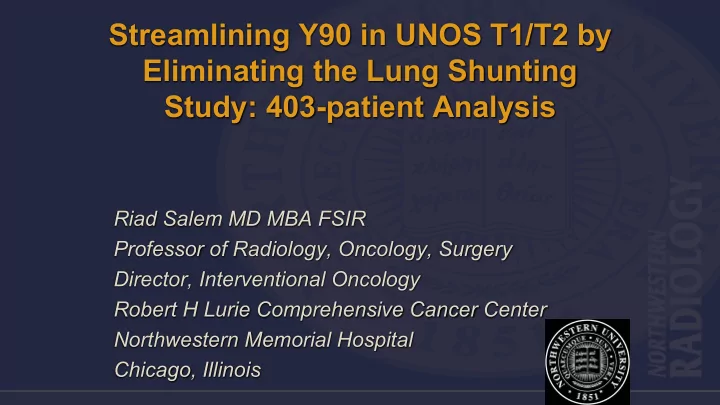

Streamlining Y90 in UNOS T1/T2 by Eliminating the Lung Shunting Study: 403-patient Analysis Riad Salem MD MBA FSIR Professor of Radiology, Oncology, Surgery Director, Interventional Oncology Robert H Lurie Comprehensive Cancer Center Northwestern Memorial Hospital Chicago, Illinois
Disclosures Consultant Grant/Research Support • BTG UK Ltd • BTG UK Ltd • Boston Scientific • BMS • Dova Scientific Advisory Board • BTG UK Ltd • Cook • Eisai • Exelixis
Gaba et al. Radiology 2014
RESULTS: • A total of 734 technetium-99 m macro aggregated albumin studies were identified in 653 patients. • Among these cases, the liver tumor was hepatocellular carcinoma in 368 (50.1%), colorectal cancer in 112 (15.3%), neuroendocrine tumor in 89 (12.1%), cholangiocarcinoma in 59 (8.0%), breast cancer in 27 (3.7%), and other metastatic malignancies in 79 (10.7%). • The mean lung shunt fraction for non-hepatocellular carcinoma cases was 7.4%, which was significantly lower than the mean lung shunt fraction , 11.7%, for hepatocellular carcinoma cases (P = 0.0001). • In only one non-hepatocellular carcinoma case was yttrium-90 radioembolization not pursued due to high lung shunt fraction (69.3%). • In comparison, the lung shunt fraction was too high to pursue radioembolization in 37 hepatocellular carcinoma cases (mean lung shunt fraction 35.1%). Elsayed et al. Nuc Med Communicaitons 2019
C ONCEPT • Subset of patients that current paradigm is challenging: • Travel challenges • Distance • Poor infrastructure • Procedural challenges • Difficult vascular access • Contrast allergy • Benefits: • Less travel • Cost savings • Fewer procedures à fewer potential risks • More competitive with other embolization procedures
• 78 patients (2008-2015) D EMOGRAPHICS : • 9% (7/78) were international • 18% (14/78) were from out-of-state • 55% (43/78) traveled from outside city limits • 18% (14/78) local residents • 77% (61/78) with HCC • 22% (17/78) with liver metastases EJNMMI 2016
EJNMMI 2016
L I ET AL JVIR 2019
W ORK F LOW Lobar Angiography/Call Nuclear Medicine Cone Beam CT Lobar MAA Administration/Transfer to Nuclear Medicine Selective Catheterization Radioembolization
Methods: Ø Inclusion criteria: • early stage HCC (UNOS T1/T2/Milan criteria)solitary ≤5 cm, 3 nodules ≤3 cm). Ø LSF was estimated using MAA scanning in all patients. Ø Associations between LSF and baseline characteristics were investigated. Ø A “no-MAA” paradigm was then proposed based patients that expressed negligible LSF values and low risk of lung doses.
Results: Ø Median LSF was 3.9% (IQR: 2.4%-6.2%). Ø Median administered activity was 0.96 GBq (IQR: 0.64-1.4), for a median segmental volume of 0.2 kg (IQR: 139.5-340.5) grams. Ø Median lung dose was 1.9 Gy (IQR: 1.0-3.4). Ø The presence of TIPS (N=35) was associated with LSF>10% (OR=10.79, CI:4.47-26.03, P<0.0001). Ø Median LSF was 3.9 (IQR: 2.4-5.9%) and 6.3 (IQR: 3.7-14.2%) in TIPS vs no-TIPS patients (P=0.0001).
W ORK F LOW Lobar Angiography/Call Nuclear Medicine Cone Beam CT Lobar MAA Administration/Transfer to UNOS T1/T2 Nuclear Medicine Selective Catheterization Cone Beam CT Radioembolization Radioembolization- Rad Seg
66 Y / O M ALE WITH HBV 5/27/14
FOLLOW-UP 1 month post Y90
C ONCLUSIONS : P RINCIPLES OF NO - MAA Y 90 • Patient selection • Select segmental-never need to embolize UNOS T1/T2 • Perform planar scan only • cone beam supersedes SPECT/CT findings • Assume 2 vessels perfusing the tumor • Complete elimination of MAA in UNOS T1/T2 • “ The 1 hour Y90 ”
Recommend
More recommend